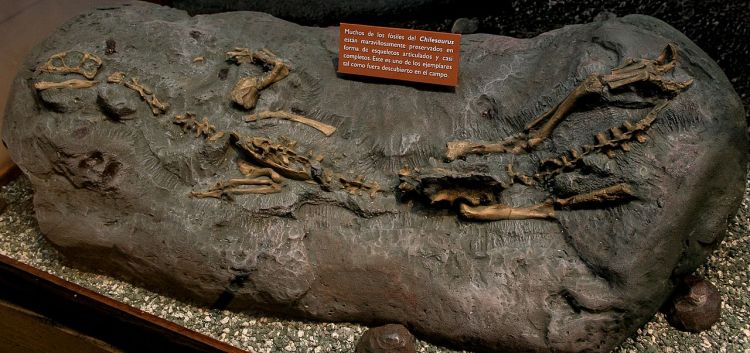
Chilesaurus holotype cast (MACN. From Wikipedia Commons. Author: Evelyn D’Esposito)
Chilesaurus diegosuarezi is a bizarre tetanuran from the Upper Jurassic of southern Chile. Holotype specimen (SNGM-1935) consists of a nearly complete, articulated skeleton, approximately 1.6 m long. Four other partial skeletons (specimens SNGM-1936, SNGM-1937, SNGM-1938, SNGM-1888) were collected in the lower beds of Toqui Formation. For a basal tetanuran, Chilesaurus possesses a number of surprisingly plesiomorphic traits on the hindlimbs, especially in the ankle and foot, which resemble basal sauropodomorphs.
All the preserved specimens of Chilesaurus show ventrally flexed arms with the hands oriented backwards, an arrangement that closely resembles the resting posture similar described in Mei long, Sinornithoides youngi, and Albinykus baatar. However, the hindlimbs of Chilesaurus are posteriorly extended, rather than ventrally flexed. So it seems that individuals of Chilesaurus were buried quickly and fossilized almost in life position during passive activity (e.g. feeding, resting).

Cast of SNGM-1937 specimen of Chilesaurus diegosuarezi in dorsal (1), 471 lateral (2), and anterolateral view (3). Scale: 20 mm.
The specimen SNGM-1937 shows an angular relation in the wrist that resembles that in Deinonychus. In fact, several coelurosaurs have the same resting position as the forelimbs of Chilesaurus, with the humerus and radius-ulna in perpendicular relation or elbow flexed in an acute angle, hands under the radius-ulna, and palmar surface posterodorsal and dorsomedial oriented with respect to the main body axis. The resting posture of the forelimbs has been studied in theropod species, in relation to the acquisition of flight. It was suggested that the presence of the forelimb folded structure in advanced theropods are related with soft structures, as patagial skin and muscles, present in several maniraptoran dinosaurs.
The cojoined flexion of wrist and elbow in living birds is mainly conducted by the action of a large number of tendons located within the propatagium. Although the existence of propatagium was considered as unique to modern birds, it have also been described for coelurosaurs and Pterosauria. The preserve of a flexed forearm in Chilesaurus, may be also regarded as an indirect indicative of the presence of propatagium in this taxon.
References:
Nicolás R. Chimento, Federico L. Agnolin, Fernando E. Novas, Martín D. Ezcurra, Leonardo Salgado, Marcelo P. Isasi, Manuel Suárez, Rita De La Cruz, David Rubilar-Rogers & Alexander O. Vargas (2017) Forelimb posture in Chilesaurus diegosuarezi (Dinosauria, Theropoda) and its behavioral and phylogenetic implications. Ameghiniana (advance online publication) doi: 10.5710/AMGH.11.06.2017.3088
Novas, F.E., Salgado, L., Suarez, M., Agnolín, F.L., Ezcurra, M.D., Chimento, N.R., de la Cruz, R., Isasi, M.P., Vargas, A.O., and Rubilar-Rogers, D. 2015. An enigmatic plant-eating theropod from the Late Jurassic period of Chile. Nature 522: 331-334. doi:10.1038/nature14307